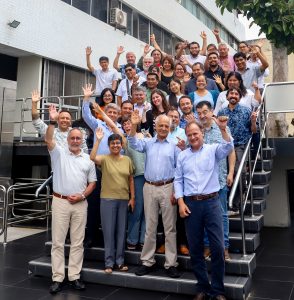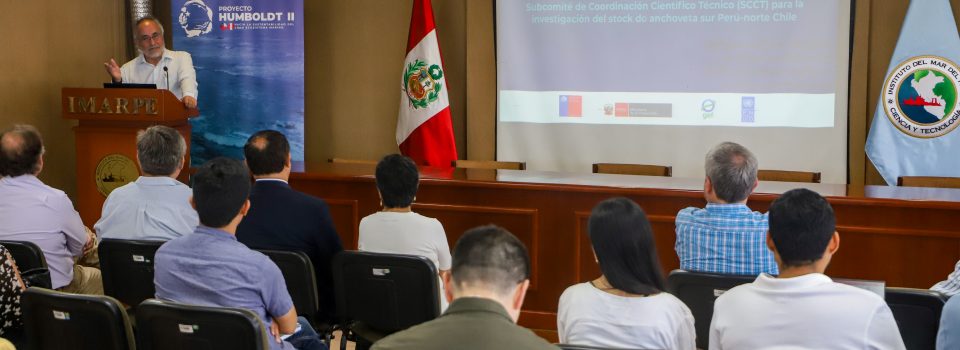Researchers from Chile and Peru meet to promote scientific collaboration for shared anchovy stock sustainable management
February 6th, 2024 More than 40 researchers from Peruvian Sea Institute (IMARPE) and Chilean Fisheries Development Institute (IFOP) met to agree on protocols and research methods for shared anchovy stock located in southern Peru and northern Chile.
More than 40 researchers from Peruvian Sea Institute (IMARPE) and Chilean Fisheries Development Institute (IFOP) met to agree on protocols and research methods for shared anchovy stock located in southern Peru and northern Chile.
Within “Catalyzing Strategic Action Program implementation for Humboldt Current System sustainable management of shared living marine resources”, known as “Humboldt Project II” framework, executed by Fisheries and Aquaculture Chilean Undersecretariat (SUBPESCA) and Fisheries and Aquaculture Vice Ministry of Peru’s Production Ministry (VMPA-PRODUCE) and implemented by United Nations Development Program (UNDP) with co-financing from Global Environment Facility ( GEF, for its acronym in English), the meeting was organized to establish Scientific and Technical Coordination Subcommittee Binational Working Groups (SCCT) for anchovy stock south of Peru-northern Chile’s investigation. This project seeks, among other tasks, fishing resource population biomass recovery and maintenance, with anchovy stock prioritization in southern Peru and northern Chile. This meeting was held at Peruvian Marine Institute (IMARPE), headquarters January 24th and 25th, 2024.
At the meeting opening, Rear Admiral Jorge Paz, Instituto del Mar del Peru (IMARPE)Board of Directors President, offered welcome words and indicated: “This Binational Scientific Technical Subcommittee is of vital importance for scientific research development of shared stock of anchovy, a key marine resource in our region. Collaboration between experts from both countries will allow us to deepen anchovy’s behavior, distribution and life cycle research of crucial aspects for sustainable management of this species so relevant to our fisheries.
For his part, Jorge Castillo, Chilean Fisheries Development Institute (IFOP),researcher highlighted the importance of joint management between Chile and Peru “‘Shared anchovy stock is a resource that supports an important economic activity for Chile and Peru . “Both countries are focused on applying an ecosystemic approach to fishing resources in order to advance a more sustainable and lasting evaluation over time.”
The meeting was attended by more than 40 researchers from IFOP, IMARPE, Peruvian and Chilean universities, Applied Marine Research Center (CIAM) from Chile and Humboldt Institute for Marine and Aquaculture Research (IHMA) from Peru. The meeting aims to strengthen scientific collaboration between both nations and advance the conservation of shared anchovy stock and sustainable management of its fishery in the Humboldt Current Ecosystem.
During the meeting, five Binational Working Groups were established: 1) Direct Assessments GTB, 2) Indirect Assessments GTB, 3) Fisheries Oceanography and Biophysical Modeling GTB, 4) Fisheries Biology, Reproduction and Growth GTB , 5) Bio-socioeconomics and Ecosystem Modeling GTB. These Working Groups seek to reduce knowledge gaps regarding anchovy stock and implementation of agreed-upon research protocols and methods. During the meeting, detailed roadmaps were drawn up for each GTB, defining the specific activities to be carried out within the framework of the GEF/UNDP Humboldt II project. during the period 2024-2026.
Work groups
Direct Evaluations GTB : This group will focus on agreeing protocols for evaluation with direct methods, simultaneous, sequential or joint, of anchovy south of Peru – north of Chile (SPNCH) shared stock. Additionally, they will coordinate assessment cruises and oceanography activities to obtain accurate and relevant data.
Indirect Assessments GTB: Its main task will be to agree standardized methods for joint SPNCH anchovy stock assessments through modeling. They will also carry out at least one joint stock assessment of stock, using innovative approaches and advanced technologies.
Fisheries Oceanography and Biophysical Modeling GTB: This group will focus on biophysical model development with standardized data and a common conceptual model. These models will explain anchovy recruitment and spawning biological milestones, thus contributing to a deeper understanding of the dynamics of the resource.
Fisheries Biology, Reproduction and Growth GTB: Its function will be to support catch and effort data standardization, to improve anchovy’s reproductive biology understanding, as well as its growth in size. This will provide crucial information to understand the resource’s life cycle.
Bio-socioeconomics and Ecosystem Modeling GTB: This group will advance in bioeconomic and ecosystemic modeling of fishery, considering social , economic and ecosystemic aspects. Likewise, it will focus on designing and implementing predictive models that help plan management in various environmental variability scenarios.
With these Binational Working Groups formal constitution and heir roadmaps definition, a milestone is marked for southern Peru-northern Chile anchovy’s research and a solid foundation is established for scientific collaboration between both countries. that allows progress towards coordinated and sustainable management of shared anchovy stock. This joint effort reflects both nations commitment in this resource’s conservation, in sustainable development of their fishery in line with sustainable development goal (SDG) 14 of the United Nations and in the effective implementation of the Humboldt II Project.
